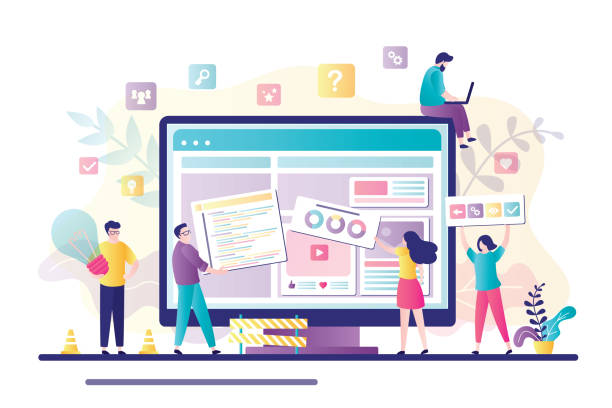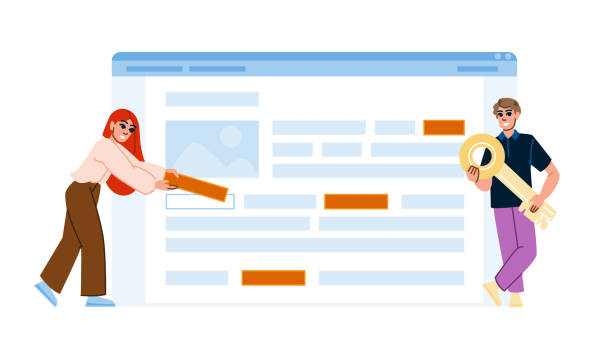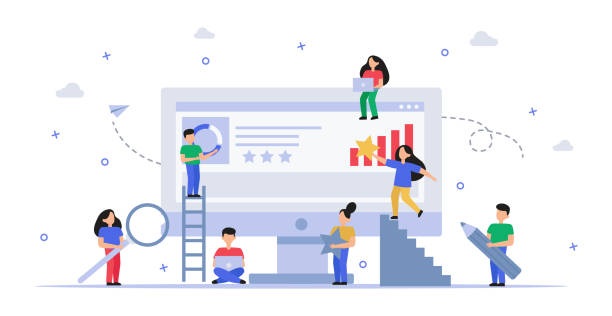Introduction and Importance of Multilingual Website Design in the Digital Age

In today’s world, where geographical boundaries have less meaning in the virtual space, a strong online presence is vital for any business.
But how widespread can this presence be? This is where the concept of #multilingual_website_design comes into play.
A single-language website, no matter how excellent its content, can only connect with a limited segment of global users.
The need to expand reach to international audiences has driven companies to invest in multilingual website design.
This approach is not just an option, but a strategic necessity for growth and survival in competitive markets.
The main goal of this comprehensive explanatory and educational guide is to familiarize you with various aspects of this vital process. Designing a website with support for multiple languages allows your brand’s message to be effectively conveyed to audiences with different languages and cultures.
This not only helps increase website traffic but also provides a better user experience for visitors and gains their trust.
Ultimately, multilingual website design empowers you to compete in global arenas and gain a larger market share.
Did you know that 94% of a company’s first impression is related to its website design?
Rasaweb, by providing professional corporate website design services, helps you create the best first impression.
✅ Create a professional and reliable image for your brand
✅ Easier attraction of potential customers and improved online presence
⚡ Get free corporate website design consultation
Competitive Advantages of Multilingual Websites in Global Markets

Investing in multilingual website design is more than a simple technical change; it’s a strategic step towards achieving sustainable competitive advantage.
A multilingual website allows businesses to access markets that were previously impenetrable due to language barriers.
This geographical expansion means a potential increase in customers, sales, and revenue.
One of the most significant benefits of this approach is a considerable improvement in Search Engine Optimization (SEO).
Websites that offer their content in different languages achieve better rankings in local search results for those languages.
This means more organic traffic and, ultimately, increased brand awareness.
Furthermore, providing information in users’ native languages creates a sense of trust and comfort, which in turn leads to higher conversion rates.
This analysis indicates that multilingual website design is not just an expense, but a profitable investment in the future of your business. These global platforms present an image of professionalism and customer-centricity, ultimately leading to greater customer loyalty and stronger return on investment.
Ignoring this aspect means losing countless opportunities in today’s e-commerce world.
Consequently, for any business considering international growth and expansion, multilingual website design is a strategic and vital decision.
Challenges and Solutions for Multilingual Website Design

Implementing multilingual website design, while offering many benefits, also comes with challenges that require careful planning and specialized solutions.
One of the main challenges is content management and translation.
Simply translating words is not enough; content must be localized to align with the culture and values of the target audience in each language.
This includes adapting terminology, units of measurement, dates, and even colors and images.
Another challenge involves technical issues related to multilingual SEO, including selecting the appropriate URL structure (subfolder, subdomain, or dedicated domain) and correctly using hreflang tags to inform search engines about different language versions of a page. Additionally, ensuring design compatibility with various languages, especially those written from right-to-left (like Persian and Arabic), is crucial.
To overcome these challenges, using powerful Content Management Systems (CMS) with built-in multilingual capabilities or specialized plugins is recommended.
Collaboration with professional translators and cultural localizers is also essential to ensure content quality and accuracy.
Here is a guide table comparing different translation methods:
| Translation Method | Advantages | Disadvantages | Suitable For |
|---|---|---|---|
| Human Translation | High accuracy, cultural localization, tone preservation | High cost, time-consuming | Sensitive content, marketing, legal |
| Machine Translation (AI) | High speed, low cost, high volume | Lower accuracy, no localization, requires editing | Internal content, basic information |
| Hybrid Translation (Machine + Human) | Balance between speed and accuracy, reduced cost | Requires efficient management process | Most multilingual websites |
Ultimately, successful multilingual website design requires a comprehensive approach that encompasses both technical and content/cultural aspects.
Choosing the Right Technology for Multilingual Implementation

One of the key decisions in the multilingual website design process is choosing the appropriate platform and technology.
This choice directly impacts the ease of management, flexibility, and future development capabilities of your website.
For implementing a multilingual platform, you have several options.
Content Management Systems (CMS) like WordPress, Drupal, and Joomla are among the most popular choices, offering specialized multilingual plugins and modules.
For example, in WordPress, plugins like WPML or Polylang simplify content management in various languages.
These platforms allow you to launch and manage a multilingual website without needing deep programming knowledge. However, for larger projects with specific requirements, developing a custom system or using programming frameworks like React or Angular might be a more specialized approach that offers greater control over all aspects.
The important point is that the chosen technology must technically support all desired languages, including special characters and text direction (LTR/RTL).
Also, the ability to integrate with translation tools and content management systems to optimize workflow is highly important.
This specialized guidance indicates that choosing the right platform is the foundation for success in multilingual website design.
How much does losing business leads due to an unprofessional website cost you? Solve this problem forever with professional corporate website design by Rasaweb!
✅ Increase credibility and trust of potential customers
✅ Easier attraction of new business leads
⚡ Get free consultation now!
Content Strategy and Localization in Multilingual Websites

One of the most fundamental steps in multilingual website design is developing a comprehensive content strategy and precise localization.
Simply translating words from one language to another is not enough; content must be carefully localized to align with the cultural, social, and even political context of the target audience.
This process goes beyond literal translation and includes adapting idioms, phrases, units of measurement, dates, names, and even images and colors to be understandable and appealing to local audiences. For instance, a marketing campaign successful in one culture might be completely unsuccessful in another due to subtle differences in language and customs.
Thought-provoking content means you should ask yourself: Does this content convey the same meaning to the target audience in that specific language and culture? Does it evoke similar emotions? Is the content compatible with their values and norms? Collaborating with native localizers and translators, who are not only fluent in the language but also deeply familiar with the region’s culture, is crucial for ensuring the quality and effectiveness of localization.
These teams can ensure that your message is not only correctly understood but also effectively reflected in a manner appropriate to the local culture.
The content strategy must include planning for new content creation, updating existing content, and ensuring its compatibility across all language versions.
Ultimately, success in multilingual website design depends on your ability to connect deeply and effectively with each audience, in their own language and culture.
Search Engine Optimization (SEO) for Multilingual Websites

Search Engine Optimization (SEO) for a multilingual website has its specific complexities that go beyond SEO for single-language sites.
The main goal is for search engines to correctly identify which version of your content is appropriate for which language and geographical region.
One of the most important tools for this purpose is the correct use of hreflang tags, which help Google and other search engines understand the relationship between similar pages in different languages. Choosing the appropriate URL structure is also crucial; you can use subfolders (e.g., yoursite.com/fa/), subdomains (fa.yoursite.com), or even country-code top-level domains (ccTLDs like yoursite.ir).
Each method has its own advantages and disadvantages, and its selection depends on your overall strategy.
Performing keyword research for each language separately is a specialized and essential step.
Keywords that are successful in one language are not necessarily effective in another, as search habits and terminology may differ.
Furthermore, page loading speed in each geographical region should be considered, as this factor impacts SEO ranking and user experience.
Using a CDN (Content Delivery Network) can help improve speed for global users.
This analytical guide emphasizes the importance of a comprehensive approach to SEO in multilingual website design, because without it, even with the best content, reaching the target audience will be difficult.
This continuous and specialized process ensures that your site is well-visible in international markets and attracts targeted traffic.
Content Management and Updates in Multilingual Platforms

After launching a multilingual website, the main challenge shifts to continuous content management and updates across all languages.
This process requires an organized workflow to ensure that all language versions of a page remain synchronized and up-to-date.
As news content and product updates are continuously published, there is a need for a robust system to quickly translate and publish them in all languages. A Translation Management System (TMS) can be very useful in this regard, helping translation teams work more efficiently.
Training team members on how to use the multilingual platform and adhere to localization guidelines is also crucial.
Ensuring that all images, videos, and multimedia elements are also properly localized for each language is an important part of this process.
For example, video subtitles or dubbing must be accurately translated.
This educational and managerial aspect ensures that your multilingual website consistently provides accurate and relevant information to all its audiences.
Here is a checklist for updating multilingual content:
| Action | Description | Responsible | Status |
|---|---|---|---|
| Original Content Creation | Create new content or update existing content in the original language | Content Team | Done/In Progress |
| Send for Translation | Send new content to translation team/TMS | Project Manager | Done/In Progress |
| Localization and Translation | Translate and localize content for each target language | Native Translators | Done/In Progress |
| Review and Editing | Review translated content for accuracy and quality | Editors | Done/In Progress |
| Content Publishing | Publish all language versions on the website | Web Team | Done/In Progress |
| SEO Check | Ensure correctness of hreflang tags and URLs | SEO Specialist | Done/In Progress |
This approach ensures that your multilingual website design project remains successful and efficient over time.
User Experience (UX) and User Interface (UI) in Multilingual Websites

A successful multilingual website design is not merely limited to accurate content translation; it must also optimize User Experience (UX) and User Interface (UI) for each language and culture.
User experience refers to the ease and enjoyment a user derives from interacting with the site, while user interface refers to the visual and interactive design of site elements.
One of the most important aspects is designing a simple and clear mechanism for changing the language.
This language switcher should be easily accessible (usually in the header or footer of the site) and visually distinct.
Furthermore, it should be noted that the length of words and phrases can vary significantly across different languages, which impacts responsive design and the necessary space for text.
For example, a button that takes up little space in English might become much longer in German and require more space.
Also, text direction (LTR for English and RTL for Persian or Arabic) requires precise settings in CSS and overall design for elements to rearrange correctly. Using fonts that support all characters of different languages is also crucial.
This analytical and engaging aspect of design ensures that users, regardless of their native language, feel comfortable and can easily navigate your site.
Multilingual website design that pays sufficient attention to UX and UI not only retains visitors but also converts them into loyal customers and significantly contributes to your brand’s international reputation.
This attention to detail is the main distinguishing factor of a truly successful multilingual website.
Are you tired of your company’s website not meeting your expectations? With Rasaweb, design a professional website that truly represents your business.
✅ Increase attraction of new customers and sales leads
✅ Boost your brand’s credibility and trust among audiences
⚡ Get a free website design consultation!
Measuring Success and Analyzing Performance of a Multilingual Website

After launching and optimizing multilingual website design, the next crucial step is performance measurement and data analysis.
This allows you to evaluate the effectiveness of your multilingual strategy, identify strengths and weaknesses, and make data-driven decisions for future improvements.
Web analytics tools like Google Analytics offer powerful capabilities for tracking site performance based on language and geographical region.
You can examine metrics such as incoming traffic to each language version, Bounce Rate, time on page, Conversion Rate, and user paths, broken down by language.
This analysis helps you understand which languages or geographical regions yield the highest returns and which areas need improvement. For example, if the bounce rate on the Spanish version of your site is high, it might indicate localization issues or inappropriate content for that audience.
Conducting A/B tests on different translated or localized content versions can also help you identify the best approaches.
Monitoring keyword rankings in local search engines for each language is also essential to ensure the effectiveness of your multilingual SEO strategy.
This analytical approach creates a continuous feedback loop that enables you to continuously improve your multilingual website design and ensure your investment yields the best possible returns.
This data not only provides insights but can also generate thought-provoking content for future improvements.
The Future of Multilingual Website Design and New Trends

The digital world is constantly evolving, and multilingual website design is no exception.
New trends and emerging technologies are shaping the future of this field and providing unprecedented opportunities for businesses.
One of the most important of these trends is the significant advancements in Artificial Intelligence (AI) and Machine Learning in the field of translation.
While traditional machine translation often came with grammatical errors and a lack of cultural context, new AI models are capable of producing much more accurate and natural translations, reducing the need for human editing.
Furthermore, with the increasing popularity of voice assistants and voice search, optimizing content for these types of searches in different languages is becoming increasingly important. This is a specialized field that requires a deep understanding of how people speak in different languages.
Virtual Reality (VR) and Augmented Reality (AR) can also play a significant role in providing immersive multilingual experiences, where users can engage with interactive content in their own language.
These changes transform the nature of multilingual website design from a static process into a dynamic, technology-driven one.
Businesses that understand and adopt these trends can lead in global markets.
This thought-provoking content helps you look into the future and be ready to align your multilingual website with upcoming developments, which in itself means maintaining a sustainable competitive advantage in the digital world.
Frequently Asked Questions
| Question | Answer |
|---|---|
| What is multilingual website design? | It is designing a website whose content is available to users in several different languages, so that users can choose their preferred language. |
| Why is a multilingual website important? | To reach international audiences, increase website traffic, improve user experience for non-Persian speaking visitors, and expand business in global markets. |
| What are the advantages of having a multilingual website? | Increased international SEO, attracting new customers from different countries, boosting business credibility and professionalism, and reducing bounce rate by providing understandable content. |
| What are the methods for implementing a multilingual website? | Using subfolders (like example.com/en/), subdomains (like en.example.com), or separate top-level domains for each language (like example.com and example.de). |
| Which URL structure is best for international SEO? | Subdirectories (like example.com/en/) are often preferred for SEO due to the consolidation of main domain authority, although each method has its own advantages and disadvantages. |
| How does a multilingual website affect SEO? | By providing content in different languages, the site appears in local search results for those languages, increasing click-through rates and traffic, and improving the overall domain authority. Correct use of hreflang tags is crucial. |
| How is content translation managed? | Professional translators, machine translation tools (with human editing), or Content Management Systems (CMS) with built-in multilingual capabilities or relevant plugins can be used. |
| What are the common challenges in multilingual website design? | Managing translated content, maintaining design consistency across different languages, compatibility with Right-to-Left (RTL) languages like Persian and Arabic, optimizing SEO for each language, and choosing the appropriate URL structure. |
| How do I manage text direction (LTR/RTL) on a multilingual site? | For Right-to-Left languages (like Persian), you need to apply specific CSS styles to change text direction, element layout, and table direction. Often by using the `direction: rtl;` property and other related settings. |
| How can users change the site’s language? | Usually by using a button, dropdown menu, or language selector widget clearly placed in the site’s header or footer. Automatic detection of the user’s browser language and suggesting a language change is also common. |
And other services of Rasaweb Advertising Agency in the field of advertising
Smart Conversion Rate Optimization: Designed for businesses seeking online growth through custom programming.
Smart Marketing Automation: An innovative platform to improve campaign management by optimizing key pages.
Smart Marketplace: A professional solution for increasing sales with a focus on optimizing key pages.
Smart Data Analysis: A specialized service for increasing website traffic growth based on the use of real data.
Smart Marketing Automation: A specialized service for increasing website traffic growth based on Google Ads management.
And over hundreds of other services in the field of internet advertising, advertising consulting, and organizational solutions
Internet Advertising | Advertising Strategy | Advertorial
Resources
Step-by-Step Guide to Multilingual Website DesignThe Importance of SEO in Multilingual WebsitesWhy Your Business Needs a Multilingual Website?Introducing the Best Multilingual Website Design Tools
❓ For a powerful presence in the digital world, Rasaweb Afarin supports your business by providing the best digital marketing services, including corporate website design.
📍 Tehran, Mirdamad Street, next to Bank Markazi, Kazeroun Jonoubi Alley, Ramin Alley, No. 6



